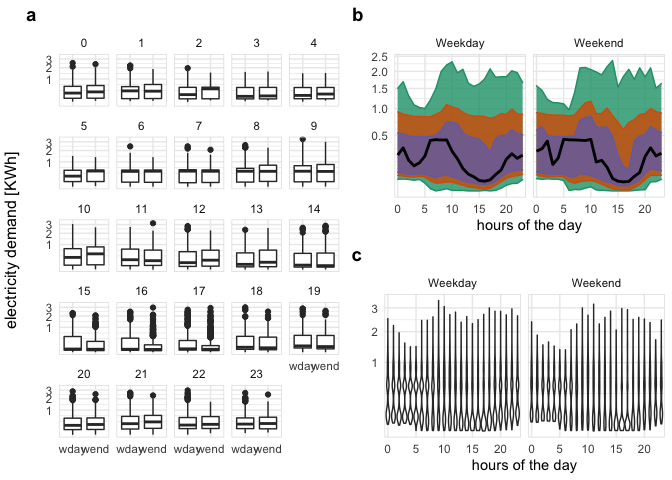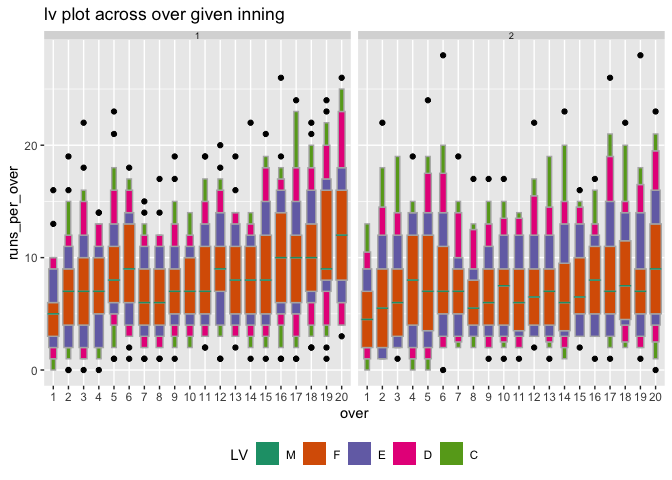Several classes of time deconstructions exist, resulting in alternative
data segmentation and, as a result, different visualizations that can
aid in the identification of underlying patterns. Cyclic granularities
is one form of time deconstruction (like hour of the day, day of the
week, or special holidays) that can be used to create a visualization of
the data to explore for periodicities, associations, and anomalies.
Package gravitas provides a tool to examine the probability
distribution of univariate time series across bivariate cyclic
granularities using a range of graphics in ggplot2 through the
following:
-
create multiple-order-up cyclic temporal granularities.
-
categorize pairs of granularities as either harmony or clash, where harmonies are pairs of granularities that aid exploratory data analysis, and clashes are pairs that are incompatible with each other for exploratory analysis.
-
recommending appropriate probability distribution plots of the time series variable across the bivariate cyclic granularities based on the levels of the granularities and their interaction.
gravitas is not restricted to temporal data. It can be utilized in
non-temporal cases for which a hierarchical structure can be construed
similar to time. The hierarchical structure of time creates a natural
nested ordering. For example, hours are nested within days, days within
weeks, weeks within months, and so on. Similarly, if a periodic nesting
exists for a non-temporal application, gravitas can be used to explore
the probability distribution of a continuous random variable.
You can install gravitas from CRAN:
install.packages("gravitas") You can install the development version from GitHub with:
# install.packages("devtools")
devtools::install_github("Sayani07/gravitas")gravitas comes with an interactive webpage, which lets you go through
the different functionalities of this package. To try it, simply use
gravitas::run_app().
-
Search for a set of all possible temporal granularities with
search_gran() -
Build any temporal granularity with
create_gran() -
Check if two temporal granularities are harmonies with
is_harmony() -
Get all possible harmonies with
harmony() -
Get recommendations on choosing more appropriate distribution plots and advice on the interaction between granularities, number of observations available for drawing probability distributions for chosen granularities with
gran_advice() -
Validate if the created granularity matches your already existing column with
validate_gran() -
Explore probability distribution across bivariate temporal granularities with
prob_plot()
The probability distribution of energy consumption for ten households from customer trials can be explored as follows:
Search for granularities
library(gravitas)
library(dplyr)
library(ggplot2)
library(lvplot)
library(ggpubr)
smart_meter10 %>%
search_gran(highest_unit = "week")
#> [1] "hhour_hour" "hhour_day" "hhour_week" "hour_day" "hour_week"
#> [6] "day_week"Screen harmonies from the search list
smart_meter10 %>%
harmony(
ugran = "day",
filter_in = "wknd_wday"
)
#> # A tibble: 7 × 4
#> facet_variable x_variable facet_levels x_levels
#> <chr> <chr> <int> <int>
#> 1 hour_day hhour_hour 24 2
#> 2 wknd_wday hhour_hour 2 2
#> 3 wknd_wday hhour_day 2 48
#> 4 hhour_hour hour_day 2 24
#> 5 wknd_wday hour_day 2 24
#> 6 hhour_hour wknd_wday 2 2
#> 7 hour_day wknd_wday 24 2Visualize probability distribution of the harmony pair (wknd_wday, hour_day)
Energy consumption of a single customer shown with different distribution displays, and granularity arrangements: hour of the day; and weekday/weekend. a The side-by-side boxplots make the comparison between day types easier, and suggest that there is generally lower energy use on the weekend. Interestingly, this is the opposite to what might be expected. Plots b, c examine the temporal trend of consumption over the course of a day, separately for the type of day. The area quantile emphasizes time, and indicates that median consumption shows prolonged high usage in the morning on weekdays. The violin plot emphasizes subtler distributional differences across hours: morning use is bimodal.
cust2_quantile <- smart_meter10 %>%
filter(customer_id %in% c(10017936)) %>%
prob_plot(
"wknd_wday", "hour_day",
response = "general_supply_kwh",
plot_type = "quantile",
symmetric = TRUE,
quantile_prob = c(0.01, 0.1, 0.25, 0.5, 0.75, 0.9, 0.99)
) +
scale_y_sqrt() +
ylab("") +
# ylab("electricity demand [KWh]") +
xlab("hours of the day") +
ggtitle("") +
theme_minimal() +
theme(panel.border = element_rect(colour = "#E0E0E0", fill = NA)
)
cust2_violin <- smart_meter10 %>%
filter(customer_id %in% c(10017936)) %>%
prob_plot(
"wknd_wday", "hour_day",
response = "general_supply_kwh",
plot_type = "violin"
) +
scale_y_sqrt() +
ylab("") +
xlab("hours of the day") +
ggtitle("") +
scale_x_discrete(breaks = seq(0, 23, 5)) +
theme_minimal() +
theme(panel.border = element_rect(colour = "#E0E0E0", fill = NA)
)
cust2_box <- smart_meter10 %>%
filter(customer_id %in% c(10017936)) %>%
prob_plot(
"hour_day", "wknd_wday",
response = "general_supply_kwh",
plot_type = "boxplot"
) +
xlab("") +
ylab("") +
ggtitle("") +
scale_x_discrete(labels = c("wday", "wend")) +
scale_y_sqrt() +
theme(axis.text.x = element_text(size = 7)) +
theme_minimal() +
theme(panel.border = element_rect(colour = "#E0E0E0", fill = NA)
)
gg_fig <- ggarrange(
cust2_box,
ggarrange(
cust2_quantile, cust2_violin,
nrow = 2, labels = c("b", "c")
),
ncol = 2, labels = "a"
)
gg_fig %>%
annotate_figure(
left = text_grob("electricity demand [KWh]", rot = 90)
)cricket data set in the package can be explored by explicitly defining
a hierarchy table as follows:
library(tsibble)
#>
#> Attaching package: 'tsibble'
#> The following objects are masked from 'package:base':
#>
#> intersect, setdiff, union
cricket_tsibble <- cricket %>%
dplyr::mutate(data_index = row_number()) %>%
as_tsibble(index = data_index)
hierarchy_model <- tibble::tibble(
units = c("index", "ball", "over", "inning", "match"),
convert_fct = c(1, 6, 20, 2, 1)
)
cricket_tsibble %>%
create_gran(
"over_inning",
hierarchy_model
)
#> # A tsibble: 8,560 x 12 [1]
#> season match_id batting_team bowling_team inning over wicket dot_balls
#> <dbl> <dbl> <chr> <chr> <dbl> <dbl> <dbl> <dbl>
#> 1 2008 2 Chennai Super Kin… Kings XI Pu… 1 1 0 4
#> 2 2008 2 Chennai Super Kin… Kings XI Pu… 1 2 0 2
#> 3 2008 2 Chennai Super Kin… Kings XI Pu… 1 3 1 4
#> 4 2008 2 Chennai Super Kin… Kings XI Pu… 1 4 0 3
#> 5 2008 2 Chennai Super Kin… Kings XI Pu… 1 5 0 3
#> 6 2008 2 Chennai Super Kin… Kings XI Pu… 1 6 0 3
#> 7 2008 2 Chennai Super Kin… Kings XI Pu… 1 7 1 1
#> 8 2008 2 Chennai Super Kin… Kings XI Pu… 1 8 1 3
#> 9 2008 2 Chennai Super Kin… Kings XI Pu… 1 9 0 1
#> 10 2008 2 Chennai Super Kin… Kings XI Pu… 1 10 0 2
#> # … with 8,550 more rows, and 4 more variables: runs_per_over <dbl>,
#> # run_rate <dbl>, data_index <int>, over_inning <fct>Visualize granularities for non-temporal data
Letter value plot of total runs per over is shown overs of the innings (x-axis) and innings of the match (facet). It can be observed that there is no clear upward shift in runs in the second innings as compared to the first innings. The variability in runs increases as the teams approach towards the end of the innings, as observed through the longer and more distinct letter values.
cricket_tsibble %>%
filter(batting_team %in% c("Mumbai Indians",
"Chennai Super Kings"))%>%
prob_plot("inning", "over",
hierarchy_model,
response = "runs_per_over",
plot_type = "lv")
#> Joining, by = c("inning", "over")
#> Joining, by = c("inning", "over")View the vignette to get started!
This package takes tsibble as the data input. Tsibble provides a data class of tbl_ts to represent tidy temporal data. It consists of a time index, key and other measured variables in a data-centric format, which makes it easier to work with temporal data. To learn more about it, please visit https://tsibble.tidyverts.org/
Thanks to PhD supervisors Prof. Rob J Hyndman, Prof. Dianne Cook and Google Summer of Code 2019 mentor Prof. Antony Unwin for their support and always leading by example. The fine balance of encouraging me to work on my ideas and stepping in to help when I need has made the development of this package a great learning experience for me.
Moreover, I want to thank my cohort at NUMBATS, Monash University, especially Mitchell O’Hara-Wild and Nicholas Spyrison for always lending an ear and sharing their wisdom and experience of developing R packages, with such kindness.
Please submit all bug reports, errors, and feature requests to https://github.com/Sayani07/gravitas/issues


